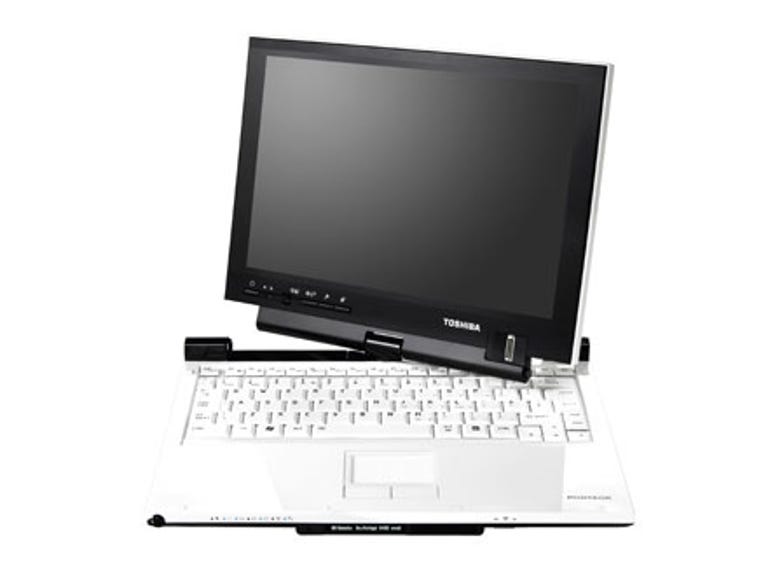 Why You Can Trust CNET
Why You Can Trust CNET Toshiba Portege R400 review: Toshiba Portege R400
At AU$3,750, this is a "premium" product, but what you get for your money is a flexible and road-worthy tablet -- but it does require extra peripherals to perform optimally.
Toshiba's Portege R400 is part of a Windows Vista-led revival in laptops and brings with it a number of useful features. Like HP and Asus, Toshiba's newest Portege came as a result of extensive collaboration with Microsoft to produce a "next-gen" device.
The Good
The Bad
The Bottom Line
Design
The Portege R400 is lightweight at 1.7kg, yet still feels solid. It also features a strong hinge which is flush with the edge -- keeping the lines clean. The LCD comes with a scratch-resistant coating, but this also makes it vulnerable to fingerprints -- however, while the screen is pointing directly at you the prints aren't visible.
Features
And one of the next things you'll notice is that there isn't an optical drive onboard. In fact, there isn't even one in the package! Toshiba said they expect many buyers of the Portege to have an external optical drive already, but presumably it was jettisoned in order to keep the cost down. Its absence can make installing extra applications difficult without an extra outlay.
Two other features make the PC significant. Firstly: the external display. It's a one-line OLED readout which can notify you of appointments and e-mails without needing to keep your laptop open -- saving battery life. It's bright, and readable from across the room, and users can set the PC up to go online briefly (with a 3G account) to download the latest headers and then go into Standby mode again.
Once given the all-clear from the Australian authorities, a wireless docking station will become available later in the year. No more shoving your PC into a rigid docking station, once it's within a metre or two of your desk your laptop will automatically sync with your peripherals and monitor. This is via an Ultra-Wide Band (UWB) wireless connection which can carry video at up to 1280x1020 resolution -- as well as enable you to connect an extra two USB devices via the wireless dock. It's expected to retail for around $350.
Performance
Converting from a notebook to a tablet was a snap, though at 1.75kg it's a little too heavy for one hand. Being one of the few tablets designed for Vista we were keen to try out the new version of Tablet, and we're happy to say that in conjunction with the active stylus, handwriting was a breeze and character recognition was mostly excellent.
Getting used to using the stylus for "gestures" proved a little more difficult, as was trying to get the screen to snap to the correct orientation once in tablet mode. Though there is a button that detects the direction the tablet is being held and orients it correspondingly, we found it behaved a little erratically and didn't always change.
One of the features that attracted us to the Toshiba is the ability to pair the notebook with your phone via Bluetooth. In theory, the notebook can automatically lock once you move beyond range, and then log back in automatically once you move back to your PC -- which is a great idea.
In practice, the "Toshiba Wireless Key Logon" works fairly poorly, and requires a lot of tweaking to try and get the proximity correct. And it will sometimes log you out when you're sitting right next to it, or will log in and out over and again even when the phone is definitely out of range. We wouldn't rely on it to secure your laptop as a result.
Until the next version of MobileMark appears, there is currently no benchmark to determine battery life under Vista. But believe us, we tried. Every test, from well-known to obscure, wilted under Vista's fiery gaze. Compatibility mode be damned, the OS won't run battery benchmarks.
Despite Toshiba's anecdotal claims of up to four hours usage, we found the R400's performance was a little more par for the course with our own anecdotal testing of two hour 20 minutes. This involved two run throughs of the PCMark05 benchmark, as well as some light Web browsing -- with some substantial rests in between. In the synthetic PCMark test the Toshiba managed a score of 2349 marks. Passable but nothing thrilling.
One thing that Vista does have is its own benchmarking system, and while a little rudimentary, it's a passable indicator of how a system performs under Windows Vista. The graphics processor is only integrated, but the score it came up with was 3.1, which means it should run Vista Aero quite well -- if not as well as a desktop.
At AU$3,750, this is a "premium" product, but what you get for your money is a flexible and road-worthy tablet. However, it's one which requires a few extra peripherals, such as an additional optical drive and the forthcoming wireless dock, to perform at its optimum.


